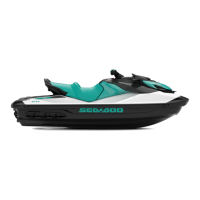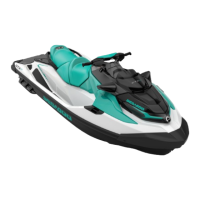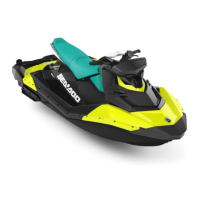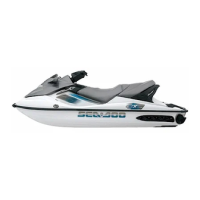Section 07 ENGINE MANAGEMENT (DI)
Subsection 03 (DIAGNOSTIC PROCEDURES)
TPS (Throttle Position Sensor) Faults
Faults which are reported in B.U.D.S. fall into two groups TPS faults and adaption faults. These are dis-
played on the B.U.D.S. system as TPS OUT OF RANGE and TPS ADAPTION FAILURE.
TPS “OUT OF RANGE” Fault
It is caused by the sensor reading going out of its allowable range. This fault can occur during the whole
range of movement of the throttle.
To diagnose this fully, it is recommended to operate the throttle through its full range. It is also recom-
mended to release the throttle quickly as this may also show up a fault that is intermittent.
POSSIBLE CAUSES RESULT ACTION
Check if wrong connector is connected
to TPS.
Ye s
• Fix.
Check if sensor is loose.
Ye s
• Fix and reset closed TPS.
Inspect sensor for damage or corrosion. Ye s
• Replace and reset closed TPS.
Inspect wiring (voltage test). Failed • Repair.
Inspect wiring and sensor
(resistance test).
Failed
• If bad wiring, repair.
• If bad TPS, replace and reset closed TPS.
Test sensor operation (wear test).
Failed • Replace and reset closed TPS.
TPS “ADAPTATION FAILURE” Fault
It is caused by the idle position moving out of an acceptable range.
POSSIBLE CAUSES RESULT ACTION
Sensor has been replaced and TPS
closed position not reset.
Yes
• Reset closed TPS.
Throttle body has been replaced and
TPS closed position not reset.
Yes
• Reset closed TPS.
MPEM has been replaced and TPS
closed position not reset.
Yes
• Reset closed TPS.
Throttle cable too tight. Yes
• Fix and reset closed TPS.
Sensor is loose.
Yes
• Fix and reset closed TPS.
Sensor is loose.
Yes
• Fix and reset closed TPS.
Throttle bracket is loose. Yes
• Fix and reset closed TPS.
Idle screw or synchronization screw
worn or loose.
Yes
• Fix and reset closed TPS.
smr2004-Complete Line Up 383

